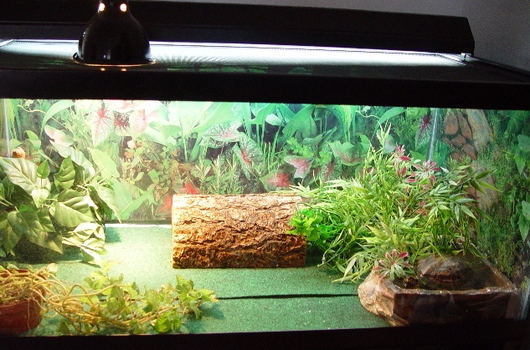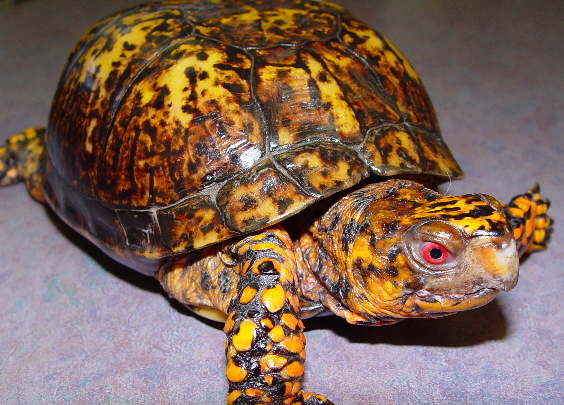Box Turtle Care (Terrapena sp.)
Erica Mede, CVT
Susan Horton, DVM
Susan Horton, DVM
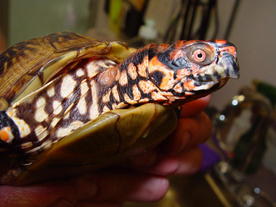 A male Three-Toed Box Turtle;
Terrapene carolina triunguis
A male Three-Toed Box Turtle;
Terrapene carolina triunguis
These inquisitive little chelonians are native to North America and have a unique hinge on their plastron that allows box turtles to withdraw their arms, legs, and head fully into their shells and seal up like a box. These animals can stay in this position for hours. In the pet industry, most of these turtles are from the wild due to the difficulty in reproducing the species in captivity. There are two species of box turtle in the US . The Eastern or Common box turtle (Terrapene carolina ) has two subspecies, the Gulf Coast box turtle (Terrapene carolina major) and the Three Toed box turtle (Terrapene carolina triunguis). The second species is the Ornate box turtle (Terrapene ornate). With a life span of roughly 25-40 years, (and a few 75-100 yr olds), these intelligent turtles often become cherished family and sometimes generational pets.
In 1975, the United States government banned the sale of any chelonian with a carapace less than four inches long in hopes of preventing the spread of Salmonella and the destruction of native species in the wild. Domestically bred box turtles are always recommended over their wild caught counterparts.
In 1975, the United States government banned the sale of any chelonian with a carapace less than four inches long in hopes of preventing the spread of Salmonella and the destruction of native species in the wild. Domestically bred box turtles are always recommended over their wild caught counterparts.
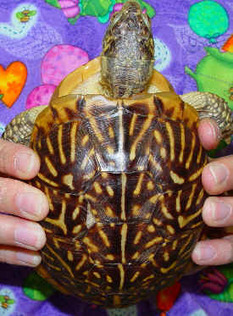 Ornate Box Turtle: Terrapene ornata ornata
Ornate Box Turtle: Terrapene ornata ornata
Special Characteristics
Life Span
They have a 25-40 year potential but occasional centenarians recorded.
Size
Hatchling are 1-1 1/2 inches long and adults are 4-8 inches long.
Coloration
Color is extremely variable among species.
Temperament
Box turtles are docile and sometimes shy. They can become quite personable and will sometimes feed from their owners hand or follow their owners when they are hungry.
Captive Care Requirements
Enclosure
The larger the enclosure the better! Hatchlings and small juveniles can be kept in glass 20 gallon aquariums but will outgrow them and will spend a significant amount of time trying to “walk through” the glass. Aquariums for adults must be large not only to offer the appropriate space needed for daily exercise and enrichment via foraging behaviors but also to allow for better air circulation. A 40-gallon aquarium or larger is suitable for adults. Building custom enclosures is a viable option and has become quite popular. 4 feet wide by 4 feet long and 12 inch high enclosures are used to house two (female and female or male and female) box turtles comfortably.
Rubbermaid containers and under the bed storage boxes are extremely popular options for housing turtles of all ages. An adult boxie can be comfortably kept in a 50-gallon Rubbermaid container or concrete mixing container. The large open tops allow for better air circulation and the rounded corners prevent escapes and make for easier cleaning. These containers are easy to clean and inexpensive to buy and can be modified to suit the turtle’s needs. Air circulation can be improved further by cutting square or rectangular pieces from the sides and placing screening over the holes. If this method is used it is recommended to place the screening on the outside of the container to prevent sharp edges from potentially coming into contact with the turtle. Outdoor accommodations should have a small pond of water for swimming and wading as well as an enclosed shelter. Outdoor enclosures must be predator and dig proof.
Life Span
They have a 25-40 year potential but occasional centenarians recorded.
Size
Hatchling are 1-1 1/2 inches long and adults are 4-8 inches long.
Coloration
Color is extremely variable among species.
Temperament
Box turtles are docile and sometimes shy. They can become quite personable and will sometimes feed from their owners hand or follow their owners when they are hungry.
Captive Care Requirements
Enclosure
The larger the enclosure the better! Hatchlings and small juveniles can be kept in glass 20 gallon aquariums but will outgrow them and will spend a significant amount of time trying to “walk through” the glass. Aquariums for adults must be large not only to offer the appropriate space needed for daily exercise and enrichment via foraging behaviors but also to allow for better air circulation. A 40-gallon aquarium or larger is suitable for adults. Building custom enclosures is a viable option and has become quite popular. 4 feet wide by 4 feet long and 12 inch high enclosures are used to house two (female and female or male and female) box turtles comfortably.
Rubbermaid containers and under the bed storage boxes are extremely popular options for housing turtles of all ages. An adult boxie can be comfortably kept in a 50-gallon Rubbermaid container or concrete mixing container. The large open tops allow for better air circulation and the rounded corners prevent escapes and make for easier cleaning. These containers are easy to clean and inexpensive to buy and can be modified to suit the turtle’s needs. Air circulation can be improved further by cutting square or rectangular pieces from the sides and placing screening over the holes. If this method is used it is recommended to place the screening on the outside of the container to prevent sharp edges from potentially coming into contact with the turtle. Outdoor accommodations should have a small pond of water for swimming and wading as well as an enclosed shelter. Outdoor enclosures must be predator and dig proof.
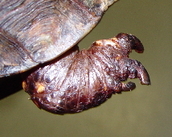
Substrate
Reptile carpet or indoor/outdoor carpet with timothy hay on top is a great substrate for box turtles. The timothy hay offers enrichment, foraging, and a little extra toe exercise as a box turtle maneuvers over the textured terrain. The carpet underneath is an excellent barrier between the boxie and the enclosure floor, especially when under tank heaters are utilized. Other substrates to consider are newspaper/newsprint, paper towel, butcher paper, and alfalfa pellets especially in younger box turtles to monitor defecation.
Box turtles are known diggers and a "dig box" of just top soil with no additives should be provided to all boxies. Great care must be taken that the substrate in the box is kept clean and changed weekly to prevent mold and excessive bacterial growth. These boxes of dirt fulfill a natural need for the box turtle while maintaining humidity in the cage. The substrate should always be moist enough to clump together but not moist enough that excess water drains out when pressed together in an owner’s hands.
Spot cleaning of feces and uneaten food should be done daily as needed and a full substrate change done every week or as needed.
Pictured here is what I call turf toe. It is a nail bed infection common in box turtles associated with malnutrition, unclean bedding and/or sharp Astroturf. Some of the shiny Astroturf will cut the skin in between the nail beds, hence the name turf toe. This foot pictured above was associated more with malnutrition, which lead to accumulation of dead skin at the nail base. This dead skin started to constrict as it dried, cutting off circulation. Next, bacteria from an unclean environment go to work and the result is pododermatitis. This will take quite some time to heal (months).
Lighting
Box turtles, like all reptilian herbivores, require daily exposure to UVB lighting. A 5.0 ReptiSun bulb helps prevent and correct calcium deficiency issues by simulating the effects of natural sun light. UVB lights should be on for the duration of the day light cycle which should be roughly 12 hours a day. All UVB bulbs must be no more than 18-24 inches away from the box turtle directly overhead and no closer than 12 inches. The bulb should be replaced every 6-12 months even if it still working to insure that the proper amount of UVB radiation is being produced.
No lighting is needed at night and is actually contraindicated. Box turtles are capable of seeing color as well as some infrared light. The use of black lights, red lights, and blue lights although marketed for reptiles can be stressful to some boxies and should be avoided. If extra heat is needed, an under tank heater or a ceramic heat emitter can be used as they have no light source.
Water
Clean water should be available at all times. The dish should be large enough for the turtle to get into and soak. Turtles often defecate in their water therefore the dish should be changed daily and disinfected weekly. It is also a good idea to soak your turtle in a shallow pan of lukewarm water for 15-20 minutes 2-3 times weekly. Always check water depth and temperature. Turtles can drown if left in too deep of water and are easily burned if water temperature is too hot.
Temperature
Box turtles thrive when their enclosures are kept between 74°F and 80°F during the day and with a basking site of 82-90°F. Day time temperatures can be maintained with basking lights, under tank heaters, heat cable, and/or heat tape. Basking lights are essential to normal thermoregulation behaviors. All under tank heaters, heat tape, and heat cables should be regulated with a thermostat to prevent injuries such as burns. It is strongly recommended all heating implements be attached to the outside of an enclosure. During the night, the temperature can drop as low as 70 °F. The night time temperature should be maintained with a ceramic heat emitter or an under tank heater if needed.
Humidity
These turtles do well in 40-50% humidity. Ornate box turtles are towards the lower end of the range. A dig box of dirt can be offered and used to maintain a higher humidity area around 70% which allows the box turtle to regulate its own requirements. The moist dig box simulates the burrows box turtles inhabit when humidity needs to be increased.
Landscaping
There should be two hide boxes available for box turtles. One should ideally be placed on the cooler side of the enclosure as well as one on the warmer side. Boxies appreciate hiding places especially for their daily naps. Hide boxes can be created from cork bark half logs, half terracotta plant pots, large PVC pipes, and wooden huts. It is necessary that the turtle be able to turn itself around in the hide area.
Rocks, drift wood, and plants (potted or fake) not only make an enclosure aesthetically pleasing to the owner, it also offers enrichment and stimulation to the box turtle. Cage accessories should be changed every week during cleaning to allow the box turtle to explore a new surrounding which not only stimulates their minds and feeds a natural behavior but also gives them a reason to exercise. Live plants should be potted to prevent up rooting and destruction of the plants.
Water dishes should be offered not only for drinking but also for soaking. Boxies enjoy soaking themselves and relieving themselves in their water bowls necessitating frequent changes. The dish should be deep enough for the box turtle to cover up to their “elbows” when standing and large enough for them to maneuver in. Soaking turtles for 10 minutes in luke warm water (84°F) 2-3 times a week will also work if a large enough water dish cannot be found.
Reptile carpet or indoor/outdoor carpet with timothy hay on top is a great substrate for box turtles. The timothy hay offers enrichment, foraging, and a little extra toe exercise as a box turtle maneuvers over the textured terrain. The carpet underneath is an excellent barrier between the boxie and the enclosure floor, especially when under tank heaters are utilized. Other substrates to consider are newspaper/newsprint, paper towel, butcher paper, and alfalfa pellets especially in younger box turtles to monitor defecation.
Box turtles are known diggers and a "dig box" of just top soil with no additives should be provided to all boxies. Great care must be taken that the substrate in the box is kept clean and changed weekly to prevent mold and excessive bacterial growth. These boxes of dirt fulfill a natural need for the box turtle while maintaining humidity in the cage. The substrate should always be moist enough to clump together but not moist enough that excess water drains out when pressed together in an owner’s hands.
Spot cleaning of feces and uneaten food should be done daily as needed and a full substrate change done every week or as needed.
Pictured here is what I call turf toe. It is a nail bed infection common in box turtles associated with malnutrition, unclean bedding and/or sharp Astroturf. Some of the shiny Astroturf will cut the skin in between the nail beds, hence the name turf toe. This foot pictured above was associated more with malnutrition, which lead to accumulation of dead skin at the nail base. This dead skin started to constrict as it dried, cutting off circulation. Next, bacteria from an unclean environment go to work and the result is pododermatitis. This will take quite some time to heal (months).
Lighting
Box turtles, like all reptilian herbivores, require daily exposure to UVB lighting. A 5.0 ReptiSun bulb helps prevent and correct calcium deficiency issues by simulating the effects of natural sun light. UVB lights should be on for the duration of the day light cycle which should be roughly 12 hours a day. All UVB bulbs must be no more than 18-24 inches away from the box turtle directly overhead and no closer than 12 inches. The bulb should be replaced every 6-12 months even if it still working to insure that the proper amount of UVB radiation is being produced.
No lighting is needed at night and is actually contraindicated. Box turtles are capable of seeing color as well as some infrared light. The use of black lights, red lights, and blue lights although marketed for reptiles can be stressful to some boxies and should be avoided. If extra heat is needed, an under tank heater or a ceramic heat emitter can be used as they have no light source.
Water
Clean water should be available at all times. The dish should be large enough for the turtle to get into and soak. Turtles often defecate in their water therefore the dish should be changed daily and disinfected weekly. It is also a good idea to soak your turtle in a shallow pan of lukewarm water for 15-20 minutes 2-3 times weekly. Always check water depth and temperature. Turtles can drown if left in too deep of water and are easily burned if water temperature is too hot.
Temperature
Box turtles thrive when their enclosures are kept between 74°F and 80°F during the day and with a basking site of 82-90°F. Day time temperatures can be maintained with basking lights, under tank heaters, heat cable, and/or heat tape. Basking lights are essential to normal thermoregulation behaviors. All under tank heaters, heat tape, and heat cables should be regulated with a thermostat to prevent injuries such as burns. It is strongly recommended all heating implements be attached to the outside of an enclosure. During the night, the temperature can drop as low as 70 °F. The night time temperature should be maintained with a ceramic heat emitter or an under tank heater if needed.
Humidity
These turtles do well in 40-50% humidity. Ornate box turtles are towards the lower end of the range. A dig box of dirt can be offered and used to maintain a higher humidity area around 70% which allows the box turtle to regulate its own requirements. The moist dig box simulates the burrows box turtles inhabit when humidity needs to be increased.
Landscaping
There should be two hide boxes available for box turtles. One should ideally be placed on the cooler side of the enclosure as well as one on the warmer side. Boxies appreciate hiding places especially for their daily naps. Hide boxes can be created from cork bark half logs, half terracotta plant pots, large PVC pipes, and wooden huts. It is necessary that the turtle be able to turn itself around in the hide area.
Rocks, drift wood, and plants (potted or fake) not only make an enclosure aesthetically pleasing to the owner, it also offers enrichment and stimulation to the box turtle. Cage accessories should be changed every week during cleaning to allow the box turtle to explore a new surrounding which not only stimulates their minds and feeds a natural behavior but also gives them a reason to exercise. Live plants should be potted to prevent up rooting and destruction of the plants.
Water dishes should be offered not only for drinking but also for soaking. Boxies enjoy soaking themselves and relieving themselves in their water bowls necessitating frequent changes. The dish should be deep enough for the box turtle to cover up to their “elbows” when standing and large enough for them to maneuver in. Soaking turtles for 10 minutes in luke warm water (84°F) 2-3 times a week will also work if a large enough water dish cannot be found.
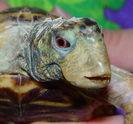
Nutrition
Box turtles are omnivores that lean more towards the carnivorous side of the spectrum. A stable diet of 50% animal protein or high protein foods, 40% vegetables and leafy greens, and 10% fruit is recommended. Earth worms are an excellent source of animal protein and should be offered at every feeding. A salad of greens such as romaine, escarole, swiss chard, mustard greens, carrots, peas, parsnips, etc should be offered every feeding as well. However, these natural carrion eaters will relish small amounts of cooked chicken as well as beef heart once a week.
Vegetables should primarily focus on calcium rich greens and beta-carotene rich foods. Avoid feeding broccoli, spinach, and kale in large quantities as these foods can cause significant gastrointestinal and urinary issues including stones. Avoid feeding dog or cat food as the excessively high protein levels can cause severe kidney problems. It helps to remember that box turtles are naturally attracted to flowers, red foods, orange foods, and yellow foods.
Juveniles should ideally be fed every day while adults should be fed every other. A calcium supplement should be used 2-3 times a week and a multi-vitamin once a week to help balance the diet. Box turtles should be fed during the day and misted prior to eating to stimulate a feeding response. For finicky eaters, finely chopped salads and even pureed salads will help to train these turtles to eat properly.
Beak problems as demonstrated in this photo, are usually associated with malnutrition, sinusitis, or trauma. I see this kind of beak most often associated with malnutrition. Once they've gotten to this stage, a normal beak occlusion surface can never be achieved. This turtle will need regular beak trimming for the rest of it's life.
Box turtles are omnivores that lean more towards the carnivorous side of the spectrum. A stable diet of 50% animal protein or high protein foods, 40% vegetables and leafy greens, and 10% fruit is recommended. Earth worms are an excellent source of animal protein and should be offered at every feeding. A salad of greens such as romaine, escarole, swiss chard, mustard greens, carrots, peas, parsnips, etc should be offered every feeding as well. However, these natural carrion eaters will relish small amounts of cooked chicken as well as beef heart once a week.
Vegetables should primarily focus on calcium rich greens and beta-carotene rich foods. Avoid feeding broccoli, spinach, and kale in large quantities as these foods can cause significant gastrointestinal and urinary issues including stones. Avoid feeding dog or cat food as the excessively high protein levels can cause severe kidney problems. It helps to remember that box turtles are naturally attracted to flowers, red foods, orange foods, and yellow foods.
Juveniles should ideally be fed every day while adults should be fed every other. A calcium supplement should be used 2-3 times a week and a multi-vitamin once a week to help balance the diet. Box turtles should be fed during the day and misted prior to eating to stimulate a feeding response. For finicky eaters, finely chopped salads and even pureed salads will help to train these turtles to eat properly.
Beak problems as demonstrated in this photo, are usually associated with malnutrition, sinusitis, or trauma. I see this kind of beak most often associated with malnutrition. Once they've gotten to this stage, a normal beak occlusion surface can never be achieved. This turtle will need regular beak trimming for the rest of it's life.
Health
Annual checkups with blood work and stool checks are recommended. Turtles hide disease extremely well therefore, it is important to pay attention to any possible signs of illness. These may include: decrease appetite, decrease activity level, discharge from eyes or nose, selling of the eyes or anywhere else, noticeable weight loss, sunken eyes, overgrown beak and/ or nails, flaky skin or any abrasions. Turtles are susceptible to nutritional deficiencies and internal parasites. At any sign of illness, the turtle should be taken to a veterinarian, (familiar with reptiles). The most common household hazard for turtles is dogs. A dog can easily puncture the shell causing serious and life threatening damage. Any turtle bitten by a dog should immediately be taken to a reptile veterinarian.
Brumation
Healthy adult box turtles can be allowed to brumate but this practice is not necessary for good health and if done inappropriately can cause health issues. An exam done by a qualified reptile veterinarian should be completed. An accurate weight in grams should be recorded every two weeks during brumation. At the weight check, the box turtle should be warmed slowly to room temperature and soaked for 30 minutes in warm water to facilitate hydration. If any sign of illness is noted or the turtle looses more than 10% of its body weight, brumation should be discontinued and veterinary care sought.
To prepare a turtle for brumation, withhold food for 10-14 days prior to brumation. Warm water soak the turtle every other day. After 14 days, start to lower the ambient temperature to 65°F over 4 days. Lower the ambient temperature to 60°F for 2 days and place them in their hibernaculum. Maintain the turtle at 45-50°F for the duration of brumation (3-4 months).
A small plastic container with small holes makes an ideal hibernaculum. A mixture of shredded or recycled newspaper product and peat moss fills the container two-thirds full and is moistened. The turtle is allowed to burrow into this material for the brumation cycle.
To end brumation, slowly increase the ambient temperature over 4-6 days and soak every other day. Once the box turtle is at normal temperature for 3 days, feeding can be resumed as normal.
Box turtles make wonderful companions. They become quite tame and bond well with their keepers. With the proper care and respect, they will live well for many years.
Annual checkups with blood work and stool checks are recommended. Turtles hide disease extremely well therefore, it is important to pay attention to any possible signs of illness. These may include: decrease appetite, decrease activity level, discharge from eyes or nose, selling of the eyes or anywhere else, noticeable weight loss, sunken eyes, overgrown beak and/ or nails, flaky skin or any abrasions. Turtles are susceptible to nutritional deficiencies and internal parasites. At any sign of illness, the turtle should be taken to a veterinarian, (familiar with reptiles). The most common household hazard for turtles is dogs. A dog can easily puncture the shell causing serious and life threatening damage. Any turtle bitten by a dog should immediately be taken to a reptile veterinarian.
Brumation
Healthy adult box turtles can be allowed to brumate but this practice is not necessary for good health and if done inappropriately can cause health issues. An exam done by a qualified reptile veterinarian should be completed. An accurate weight in grams should be recorded every two weeks during brumation. At the weight check, the box turtle should be warmed slowly to room temperature and soaked for 30 minutes in warm water to facilitate hydration. If any sign of illness is noted or the turtle looses more than 10% of its body weight, brumation should be discontinued and veterinary care sought.
To prepare a turtle for brumation, withhold food for 10-14 days prior to brumation. Warm water soak the turtle every other day. After 14 days, start to lower the ambient temperature to 65°F over 4 days. Lower the ambient temperature to 60°F for 2 days and place them in their hibernaculum. Maintain the turtle at 45-50°F for the duration of brumation (3-4 months).
A small plastic container with small holes makes an ideal hibernaculum. A mixture of shredded or recycled newspaper product and peat moss fills the container two-thirds full and is moistened. The turtle is allowed to burrow into this material for the brumation cycle.
To end brumation, slowly increase the ambient temperature over 4-6 days and soak every other day. Once the box turtle is at normal temperature for 3 days, feeding can be resumed as normal.
Box turtles make wonderful companions. They become quite tame and bond well with their keepers. With the proper care and respect, they will live well for many years.
If you have any questions, please feel free to call us at 847-329-8709.
